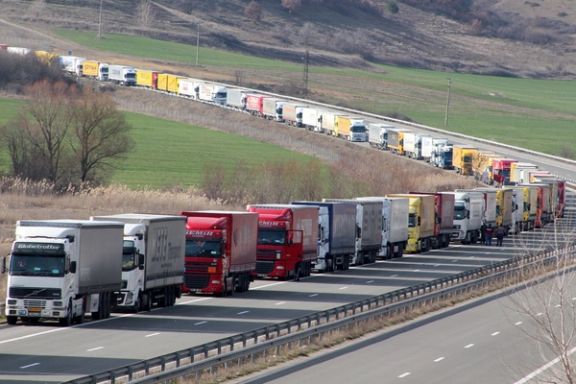Truck Owners Strike In Iran Over Fuel Quota Reduction

According to videos obtained by Iran International on Saturday, truck owners across Iran have started a strike to protest the reduction of fares and fuel quota.
The striking truck owners have refused to work in Tehran, Sistan-Baluchistan, Kerman, Ilam and Asaluyeh. In the capital Tehran, they stopped their vehicles on Babaei Highway northeast of the city.
According to Tarabaran, a news website covering Iran’s transport economy, truck owners have installed protest placards on their vehicles. They are protesting the lack or cutting of their fuel quotas, the report added.
We don’t have diesel fuel to run and there is no accountability for it in a year that has been named by Supreme Leader Ali Khamenei as “the year of surge in production with people's participation," the protesters said in mockery.
Khamenei began naming the years approximately three decades ago. Initially, "the name of the year" primarily reflected ideological and religious values, such as "the movement of serving the nation" in 2003. However, over the past 16 years, these names have predominantly focused on executive and economic issues, all of which having fallen short of realization due to the country’s worsening economic and political crises.
Meanwhile, in Sistan-Baluchistan, truck owners have refrained from loading their vehicles in different cities such as Dashtiari, Chabahar, Konarak, Nikshahr and Zarabad. Reports received by Iran International indicate that following the strike, the transportation system has been disrupted in the province, and many businesses and construction projects have stopped. Truck owners have refused to transport sand and gravel cargos to construction sites, reports added.
An informed source told Iran International that consignments from cement factories have completely ceased in some regions of Sistan-Baluchistan, while in other parts of the province, the cargos are transported very slowly.
The truck owners had warned that they would go on a nationwide strike in case their problems were not addressed by the government, said Foad Keikhosravi, a member of the board of directors of the Confederation of Iranian Labor Abroad, in an interview with Iran International.
“The fuel quota of trucks has been reduced by the government and they have run of out of fuel; if they want to buy it from the free market, it is going to be very expensive,” he went on to say, warning that the ongoing strike of the truck owners can have detrimental impacts on the livelihood of truck drivers and worker of different sectors.
Keikhosravi called on other social groups to join striking truck owners and said that the fuel problem can affect the society at large by further increasing Iran’s inflation.
Iranian truck owners went on similar strikes in recent years in protest at fuel shortages, rampant inflation, and the deprecation of Iran’s national currency. In more than a decade, Iran's economic growth has averaged zero. The situation has been further exacerbated since the US withdrawal from the JCPOA nuclear deal in 2018. In the past six years, the rial, Iran’s national currency, has fallen 15-fold, fueling inflation and plunging millions of citizens into poverty.
Earlier in the month, Jafar Salari-Nasab, the CEO of the National Iranian Oil Refining and Distribution Company (NIORDC), stated that the country is facing record gasoline consumption. The announcement sparked fears of rationing as the country battles continued shortages.
Official statistics reveal that gasoline constitutes only 28 percent of Iran's refinery products, highlighting the need for modernization akin to refineries in other neighboring countries like the United Arab Emirates.
Unconfirmed reports indicate that the Iranian government may choose to increase fuel prices or gradually reduce national subsidies in an attempt to handle the shortages. The government has already spent tens of billions of dollars on indirect subsidies of energy. Gasoline and diesel subsidies alone cost the government around $100 million a day.